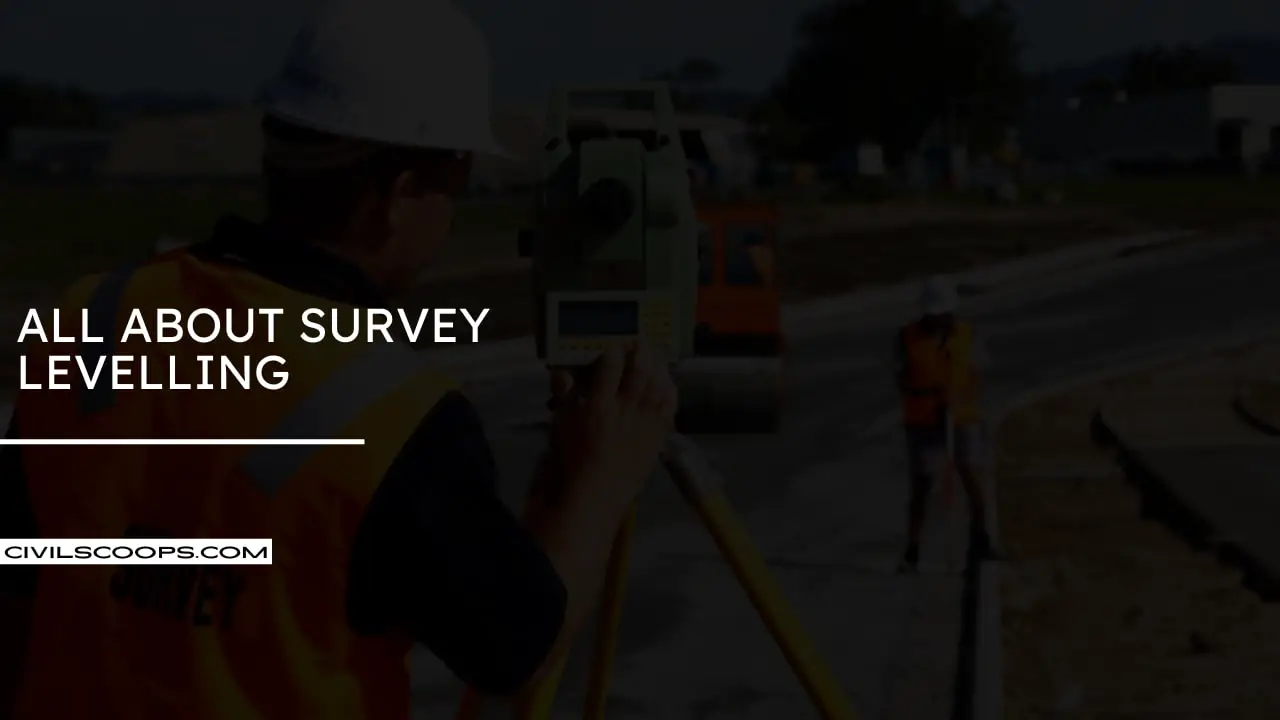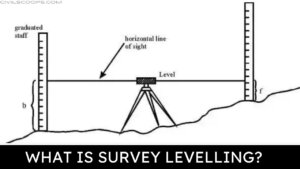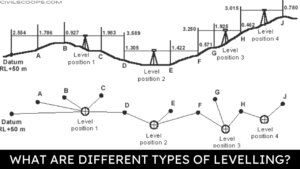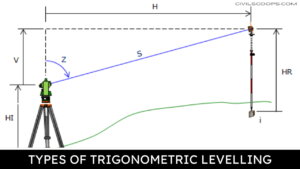What Is Survey Levelling | Important Terms Related to Levelling | What Are Different Types of Levelling | Types of Trigonometric levelling

Table of Contents
Introduction of Survey Levelling
Survey levelling is the method by which we measure the elevation of one land with respect to others. It can also be defined as a method to find out the difference of elevations of different points on the earth’s surface.
It helps surveyors and engineers to level, design, plan, and construct a building by making the land suitable for construction
What Is Survey Levelling?

Levelling is a process of determining the height of one level relative to another. It is used in surveying to establish the elevation of a point relative to a datum or to establish a point at a given elevation relative to a datum.
Important Terms Related to Levelling
Elevation
- It is the vertical distance from a reference surface called a datum.
- The elevation is in positive when the considered point is above datum and negative when the considered point is below datum.
Mean Sea Level (MSL)
- It’s a datum obtained by taking the average of hourly high and low tides elevations over a long period of time of about 19 years.
Level Surface
- A level surface is a curved surface in which all the points are at the same distance from the earth’s surface.
Level Line
- A line lying on the level surface is called a level line. It’s perpendicular to the plumb line.
Line of Sight
- It’s the line joining the optical centre of objective lens t the points of intersection of crosshairs.
Back Sight
- It’s the staff reading taken on a point of known elevation.
Foresight
- It’s the staff reading taken on a point whose elevation is yet to be determined.
- For example, if point B is to be determined, then staff reading taken on station B is called as foresight.
Intermediate Sight
- It’s the staff reading taken on the point of unknown elevation between the back sight and the foresight.
Benchmark
It’s the fixed reference point of known elevation. Benchmarks are classified into four parts:
- Great Trigonometric Benchmark
- Permanent Benchmark
- Arbitrary Benchmark
- Temporary Benchmark
What Are Different Types of Levelling?

The different types of levelling are:
- Simple Levelling
- Reciprocal Levelling
- Trigonometric Levelling
1. Simple Levelling

It’s used to find out the difference between two levels which are relatively close to each other and only one setting of an instrument is enough.
2. Reciprocal Levelling

It’s used to determine the correct difference of elevations of the two points which are too far to be measured by putting the instrument mid-way between the two points to balance the foresight and backsight.
3. Trigonometric Levelling

It’s the indirect method of levelling in which the elevation of a point is determined from the vertical angle measured with a theodolite and horizontal distance measured with a tape or a chain.
Types of Trigonometric Leveling

Here, two different types of Trigonometric Leveling methods are as follows.
- Plain Trigonometric Levelling
- Geodetic Trigonometric Levelling
1. Plain Trigonometric Levelling
It employs the principle of plain surveying. It’s assumed that the distances measured are small compared to the radius of earth and thus the effect of earth’s curvature ad refraction can be ignored.
2. Geodetic Trigonometric Levelling:
In geodetic trigonometric levelling, the distances between the points are comparable to that of earth’s radius. This is the reason that simple principles of plain surveying cannot be applied. It requires the correction due to the earth’s curvature and refraction.
- However, trigonometric levelling isn’t as accurate as direct levelling.
- With the advent of tacheometers, trigonometric levelling has now become simple because the horizontal distances also can be computed directly.
Level Field Book
It’s the book used for entering the staff readings and reduced levels of various points. There are two methods used for the calculation of reduced levels of various points
- Height of Instrument or Height of Collimation Method
- Rise and fall method
Facts about the height of the instrument method and Rise & fall method
1. Height of Instrument
- The first reading is always backsight.
- The last reading is always foresight.
2. Rise and Fall method
- All the columns are same as the height of the instrument method except one- Two columns of rising and fall will replace the HI column of the height of the instrument method.
Errors in Levelling
There are many types of errors in levelling. Which is as follows.
- Instrumental Errors
- Error Due to Imperfect Adjustment
- Error Due to Sluggish Bubble
- Error Caused by Defective Staff
- Error Caused Due to Defective Tripod
- Error Caused Due to Faulty Focusing Tube
- Personnel Errors
- Error Occurs Caused Due to Careless
- Error Occurs Due to Bubble Out of Centre
- Error Occurs Due to Imperfect Focussing
- Error Occurs Due to Sighting
- Error Due to Natural Causes
- Error Due to Curvature of Earth and Refraction
- Error Occurs Due to Temperature Variation
- Error Occurs Due to Tripod Settlement
- Error Occurs Due to Sun and Wind
1. Instrumental Errors
Instrument error refers to the error of a measuring instrument or the difference between the actual value and the value indicated by the instrument.
There can be errors of various types, and the overall error is the sum of the individual errors. Its types are as follows.
- Error Due to Imperfect Adjustment
- Error Due to Sluggish Bubble
- Error Caused by Defective Staff
- Error Caused Due to Defective Tripod
- Error Caused Due to Faulty Focusing Tube
1.1. Error Due to Imperfect Adjustment
- If the isn’t perfect in adjustment, the resulting line of sight will be inclined when the bubble is at the centre.
- It can be eliminated by balancing the foresight and backsight.
1.2. Error Due to Sluggish Bubble
- Sluggish bubble comes to rest quickly and also shift position while the sight is taken.
- This error can be avoided by making sure that the bubble is central before taking each reading.
1.3. Error Caused by Defective Staff
- This error occurs due to the inaccuracy of graduations of the staff.
- If the bottom of staff has worn out then it will five wrong height of instrument but the error in foresight is balanced by the back sight and thus the calculated elevation is correct.
1.4. Error Caused Due to Defective Tripod
- Unstable and weak tripod causes this error.
1.5. Error Caused Due to Faulty Focusing Tube
- This error occurs due to fault in focusing tube of the external focusing telescope due to which the objective moves in an inclined direction when tuce is moved for focusing.
- It can be eliminated by taking out the defective tube and aligning it properly.
2. Personnel Errors
The errors which are introduced due to fault of the observer is known as Personal error, for example, carelessness in taking observation etc. Its types are as follows.
- Error Occurs Caused Due to Careless
- Error Occurs Due to Bubble Out of Centre
- Error Occurs Due to Imperfect Focussing
- Error Occurs Due to Sighting
2.1. Error Occurs Caused Due to Careless
- Gross errors are mostly due to lack of knowledge, judgment and care on the part of an experiment.
- That is Gross error is caused by careless handling. Gross error is caused by careless handling.
st=ettig up and levelling of the instrument
2.2. Error Occurs Due to Bubble Out of Centre
- When the bubble isn’t at the centre when the sights are taken, this error occurs.
- By turning the levelling screw, we can bring the bubble at the centre and avoid this error.
2.3. Error Occurs Due to Imperfect Focussing
- When the eyepiece and objective aren’t properly focused, there will be a parallax and staff readings will have errors.
- To avoid this error, we can check if the movement of the eye causes an apparent change in staff reading.
2.4. Error Occurs Due to Sighting
- This error occurs when the crosshairs don’t coincide with the staff graduations.
- This error can be eliminated by keeping the distances small and taking care while sighting.
3. Error Due to Natural Causes
The types of Error Due to Natural Causes are as follows
- Error Due to Curvature of Earth and Refraction
- Error Occurs Due to Temperature Variation
- Error Occurs Due to Tripod Settlement
- Error Occurs Due to Sun and Wind
3.1. Error Due to Curvature of Earth and Refraction
- This error due to curvature and refraction is small and generally can be avoided.
3.2. Error Occurs Due to Temperature Variation
- Due to the high temperature, liquid of the level tube expands and bubble gets shorten, leading to the adjustments of the instruments getting disturbed.
- This error is also small and can be neglected
3.3. Error Occurs Due to Tripod Settlement
- This error occurs when the tripod isn’t set on firm ground.
- You can avoid this error by setting the tripod on firm ground.
3.4. Error Occurs Due to Sun and Wind
- This error occurs when the staff reading can’t be taken properly because of any reason like bright sunshine falling on it.
- It also occurs due to high wing disturbing the tripod.
[su_box title=”FAQ” style=”default” box_color=”#333333″ title_color=”#FFFFFF” radius=”3″ class=”” id=””]
Levelling Survey
Levelling is a process of determining the height of one level relative to another. It is used in surveying to establish the elevation of a point relative to a datum or to establish a point at a given elevation relative to a datum.
Permanent Benchmark
A readily identifiable, relatively permanent, recoverable benchmark that is intended to maintain its elevation without change over a long period of time with reference to an adopted datum, and is located where disturbing influences are believed to be negligible.
Arbitrary Benchmark
Arbitrary benchmarks are assumed to be equal to 100 meters generally and then the elevations with respect to assumed benchmark are determined.
It is commonly practised by engineering students. For GTS surveys of the country, surveyors use permanent benchmarks to calculate the elevations of different points.
Temporary Benchmark
A temporary benchmark (TBM) is a fixed point with a known elevation used for level control during construction works and surveys. Nails in road seals, or marks on kerb & channel are commonly used as temporary benchmarks.
Error Due to Curvature of Earth and Refraction
Hence the error in staff reading due to curvature of the earth = 0.0785 D2 metres, where D is the distance from the level to the
staff in kilometres.
The effect of curvature is to increase the staff reading i.e., this error is positive and so the correction is negative.
[/su_box]
[su_note note_color=”#F2F2F2 ” text_color=”#333333″ radius=”3″ class=”” id=””]
Like this post? Share it with your friends!
Suggested Read –
- Different Types of Pavers for Driveways
- Septic Tanks Are Back In! Here’s What You Need to Know About How They Work
- What Is Granolithic Floors | Construction Method | Advantages аnd Disadvantage
- How is Concrete Made | What is Concrete | Components of Concrete | How to Mix Concrete
- Mivan Shuttering | Merit & Demerit Mivan Technology | Mivan Formwork Assembly Process
[/su_note]
Originally posted 2022-06-28 19:22:59.
